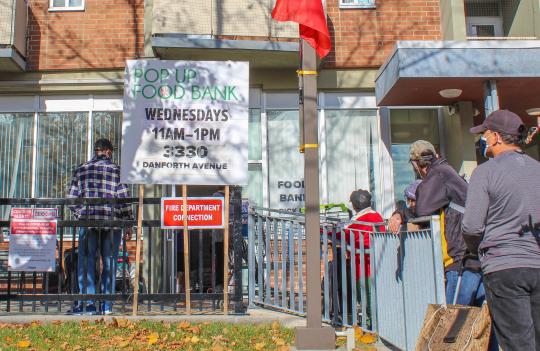
A new report co-authored by DHS scholars examines the effects of the COVID pandemic on the food security of 2SLGBTQ+ people living in the GTA, and challenges traditional conceptions of the household that make this kind of reporting difficult.
In “Queering food security research: A critical analysis of 2SLGBTQ+ People’s experiences of food insecurity in Toronto during the COVID-19 pandemic,” published in Social Science & Medicine, the authors found 42 percent of respondents reported some level of Household Food Insecurity (HFI) as the COVID-19 pandemic swept across the GTA.
Among the report authors were Department of Health and Society’s Professor Jessica Fields, as well as James Gibb, a PHD candidate at Northwestern University and Sarah Williams, Assistant Professor at the University of Connecticut. Both Gibb and Prof. Williams are former University of Toronto graduate students. Gibb was also a visiting scholar at DHS, and Prof. WIlliams is a former DHS course instructor.
This is the first study that looks at food insecurity among 2SLGBTQ+ people living in Canada, notes Prof. Fields. “We are really pointing to an inequity that's been overlooked,” she says. “Literature around food security and the pandemic doesn’t often talk about queer people.”
“There has been some recent work documenting the vulnerability that stems from queer people’s experiences with discrimination,” adds Gibb. “And then building on that, there's a much broader literature documenting resource inequities in terms of how queer people are able to access healthcare, how they are differentially affected in terms of employment, opportunities, and are more likely to be homeless. All of this signals that they are more likely to experience other manifestations of resource insecurity, in particular food insecurity.”
The report found severe HFI was higher among respondents who were bisexual, transgender/gender diverse, and/or assigned-female-at-birth. Living alone was associated with decreased odds of reporting marginal HFI but increased odds of moderate or severe HFI compared to living with a partner, family, or roommates; living with children was associated with decreased odds of both marginal and severe HFI.
One indicator of psycho-social distress (perceived discrimination) was associated with higher odds of all levels of HFI, while the other (isolation) was associated with decreased odds of marginal HFI.
Prof. Williams noted that during interviews, some respondents acknowledged that they were doing better than many in their community. “A lot of interviewees would say ’I'm pretty comfortable. I got CERB. I'm doing okay. I'm not doing as poorly as other queer people, especially unhoused people.’ So, there was a really strong awareness of who could have it worse in the community, and that a lot of people use that as their measurement for how they're doing.”
However, when more in-depth questions were asked, data about the relationship between discrimination and the ability to access food, a different story emerged. “When you get down to the nitty gritty, a lot of people did find that they were really strained in their ability to access food,” says Prof. Williams. “And you know it's not random that the part of the queer population that experiences the most food insecurity are trans, are people who are assigned female at birth, are bisexuals. And this is one of the ways that we can really zero in on the impact of not just interpersonal, but structural discrimination.”
Prof. Williams notes that while the GTA has a robust system of food banks, the further one gets from major cities, the more religious or church-affiliated organizations fill the gaps. She cautions that interpersonal discrimination is not uncommon and that often simply the expectation of discrimination is enough to deter queer people from accessing these services. She recommends that services to help access to food be managed by the government and secular organizations as much as possible.
The report also suggests a need to revise definitions of the household when measuring, monitoring, and seeking to mitigate HFI in 2SLGBTQ + communities. “I think that there are opportunities to reimagine the people that we're trying to serve and ask, who do we imagine as a household?” says Prof. Fields. “What's the picture of the family that we're representing? When we imagine homes during the pandemic or generally, who is being represented? What are the different configurations of families? And these are really simple but extraordinarily important gestures, to let people know that all of those possibilities are welcome in this space.”